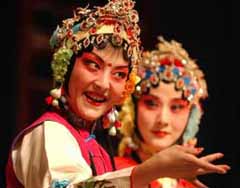 China, a cradle of the world's intangible cultural heritage, is striving to protect its traditional cultural and artistic forms from extinction in its modernized society.
China, a cradle of the world's intangible cultural heritage, is striving to protect its traditional cultural and artistic forms from extinction in its modernized society.
Though the impact of industrialization is a recent challenge in China, moves have been made to protect traditional arts, which are gradually giving way to movies and pop music.
The Xiyuan Publishing House plans to publish a series to promote Chinese folk arts.
In March, a non-governmental association launched a large-scale "emergency" project to protect folk art. With the help of the United Nations Educational, Scientific and Cultural Organization (UNESCO), the association is making verbatim recordings of ballads and operas and has released over 100 video tapes containing original performances.
Meanwhile, intangible heritage studies have been included in the curricula of college students nationwide to keep the essence of China's civilization alive among the younger generation.
UNESCO defines intangible, including oral, heritage as "the totality of tradition-based creations of a cultural community, expressed by a group of individuals and recognized as reflecting the expectations of a community".
China is one of the world's richest sources of intangible cultural heritage, according to Zhang Wenbin, chairman of the Chinese National Committee of the International Council of Museums(ICOM).
Among the most renowned pieces worldwide are the Kunqu Opera, the oldest form of Chinese folk opera that was listed in 2001 as one of UNESCO's 19 masterpieces of oral and intangible cultural heritage, and the world's longest epic poem, King Gesser, a Tibetan legendary hero.
"But they are only two examples of the numerous cultural gems of the Chinese nation," Zhang told ICOM's seventh Asia-Pacific Regional Assembly, a four-day event held in Shanghai last week.
China has so far compiled scriptures totaling six billion words,20,000 hours of voice and 5,000 hours of video recordings and many pictures, music scores and dance notations featuring its traditional artistic forms.
"This has been done by over 50,000 people over the past two decades, but is still only a fraction of China's vast resource of intangible cultural heritage," said Li Song, head of a folk art development center under the Ministry of Culture.
Analysts say China's vast cultural heritage is, first and foremost, a result of its long history -- its written civilization alone dates back over 5,000 years.
China's forefathers, after thousands of years of toiling in the fields, put down their experiences in such masterpieces as the Compendium of Materia Medica, the Exploitation of the Works of Nature and the Complete Treatise on Agriculture, all of which have benefited modern people and been recognized as invaluable heritage to the whole of humanity.
China's rich cultural heritage is also highlighted by the cultural and ethnic diversity in the world's most populous nation, experts say.
Many traditional art forms of China's ethnic groups -- Tibetans, Mongolians and Uygurs in particular -- have remained intact to this day.
The government and many non-governmental organizations have setout to protect the ancient Chinese zither, paper-cuts, the 800-year-old Ragoin school of Tibetan religious art, Sichuan opera and Yunjin brocade originating in Nanjing, capital of the eastern province of Jiangsu.
These five artistic forms have also been short listed among applications for next year's masterpieces of the oral and intangible heritage of humanity at UNESCO.
During last week's ICOM regional assembly, museum representatives from Asian and Pacific regions announced the signing of the Shanghai Charter, which urges museums to take on a larger role in the protection of intangible heritage in the Asia-Pacific region.
(eastday.com October 29, 2002)
|

